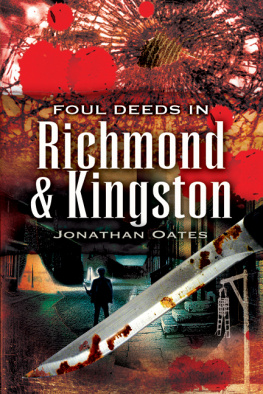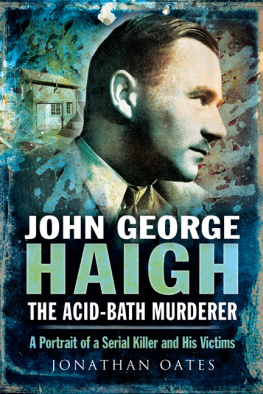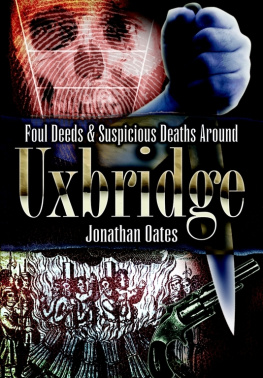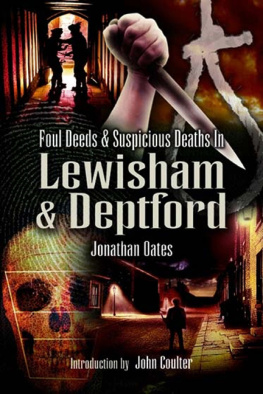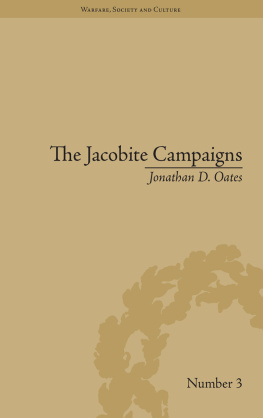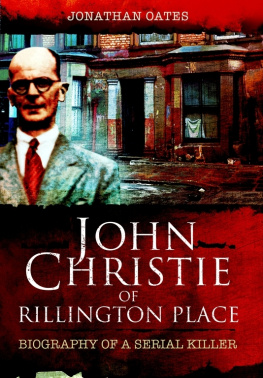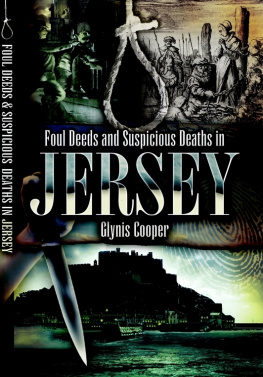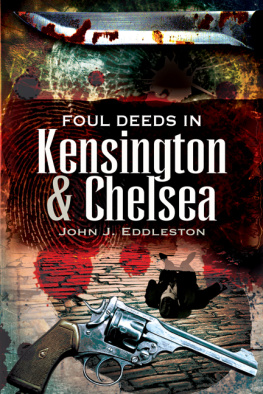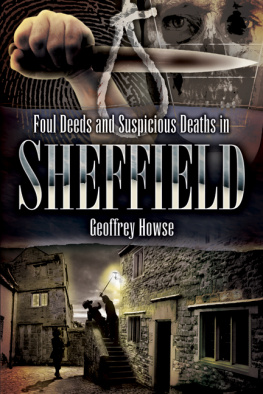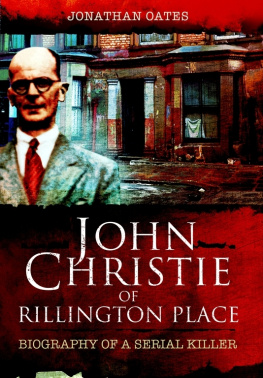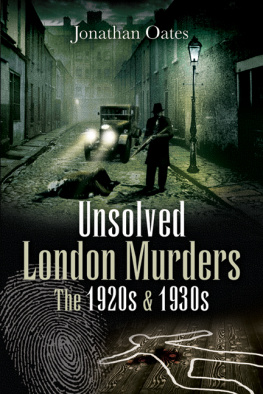
TRUE CRIME FROM WHARNCLIFFE
Foul Deeds and Suspicious Deaths Series
Barking, Dagenham & Chadwell Heath
Barnsley
Bath
Bedford
Birmingham
Black Country
Blackburn and Hyndburn
Bolton
Bradford
Brighton
Bristol
Cambridge
Carlisle
Chesterfield
Colchester
Coventry
Croydon
Derby
Dublin
Durham
Ealing
Folkstone and Dover
Grimsby
Guernsey
Guildford
Halifax
Hampstead, Holborn and St Pancras
Huddersfield
Hull
Leeds
Leicester
Lewisham and Deptford
Liverpool
London's East End
London's West End
Manchester
Mansfield
More Foul Deeds Birmingham
More Foul Deeds Chesterfield
More Foul Deeds Wakefield
Newcastle
Newport
Norfolk
Northampton
Nottingham
Oxfordshire
Pontefract and Castleford
Portsmouth
Rotherham
Sheffield
Scunthorpe
Southend-on-Sea
Staffordshire and The Potteries
Stratford and South Warwickshire
Tees
Warwickshire
Wigan
York
OTHER TRUE CRIME BOOKS FROM WHARNCLIFFE
A-Z of Yorkshire Murder
Black Barnsley
Brighton Crime and Vice 1800-2000
Durham Executions
Essex Murders
Executions & Hangings in Newcastle and Morpeth
Norfolk Mayhem and Murder
Norwich Murders
Strangeways Hanged
The A-Z of London Murders
Unsolved Murders in Victorian and Edwardian London
Unsolved Norfolk Murders
Unsolved Yorkshire Murders
Yorkshire's Murderous Women
Please contact us via any of the methods below for more information or a catalogue
WHARNCLIFFE BOOKS
47 Church Street - Barnsley - South Yorkshire - S70 2AS
Tel: 01226 734555 - 734222 - Fax: 01226 734438
Email: enquiries@pen-and-sword.co.uk
website: www.wharncliffebooks.co.uk


First published in Great Britain in 2010 by
Wharncliffe Local History
an imprint of
Pen & Sword Books Ltd
47 Church Street
Barnsley
South Yorkshire
S70 2AS
Copyright Jonathan Oates 2010
ISBN 978 1 84563 125 3
eISBN 978 1 78303 756 8
The right of Jonathan Oates to be identified as Author of this Work has been asserted by him in accordance with the Copyright, Designs and Patents Act 1988.
A CIP catalogue record for this book is available from the British Library.
All rights reserved. No part of this book may be reproduced or transmitted in any form or by any means, electronic or mechanical including photocopying, recording or by any information storage and retrieval system, without permission from the Publisher in writing.
Typeset in 11/13pt Plantin by
Mac Style, Beverley, East Yorkshire
Printed and bound in the UK
by the MPG Books Group
Pen & Sword Books Ltd incorporates the imprints of Pen & Sword
Aviation, Pen & Sword Maritime, Pen & Sword Military,
Wharncliffe Local History, Pen and Sword Select, Pen and Sword
Military Classics and
Leo Cooper.
For a complete list of Pen & Sword titles please contact
PEN & SWORD BOOKS LIMITED
47 Church Street, Barnsley, South Yorkshire, S70 2AS, England
Email: enquiries@pen-and-sword.co.uk
Website: www.pen-and-sword.co.uk
Contents
Acknowledgements
T he author wishes to thank those staff at Richmond Local Studies Centre, Kingston Local Studies Centre, Hammersmith and Fulham Local Studies Centre, the London Metropolitan Archives, the Surrey History Centre and The National Archives, for assisting in his enquiries. These included fetching maps, assisting with microfilm and archives, and dealing with Freedom of Information enquiries. Without them and their historical material, this book could not have been written. Staff at the Broadmoor Hospital dealt efficiently with enquiries. John Coulter, was, as always, helpful with his knowledge, too.
This book is dedicated to John.
Introduction
W hen Richmonds history is mentioned, most people think of Hampton Court and Henry VIII. Crime does not obviously spring to mind, whereas it would if Whitechapel or Notting Hill were mentioned. Some books about Richmond and Kingston do not even allude to it. Yet criminal activity does not recognise geographical or social boundaries and this book aims to demonstrate this. Foul Deeds in Richmond and Kingston covers a number of serious crimes which took place in what are now the London Boroughs of Kingston on Thames (Norbiton, Surbiton and Kingston itself) and Richmond (Barnes, Mortlake, Teddington, Hampton, Twickenham and Richmond), from the early nineteenth century until the 1950s. Some are shocking indeed, such as the murder and dissection of Mrs Thomas, by her servant, Kate Webster, in Richmond, in 1879 and the savage killing of two teenagers on the Teddington towpath in the 1950s. The alleged poisoning of Louisa Bankes in 1859 was once a cause celebre , but all these have now been mostly forgotten, except by crime buffs. In their day all were reported as national news. There are also unsolved murders, killings in Richmond Park and other foul crimes.
This book does not aim to be comprehensive, due to limitations of space; therefore other murders in these districts can be found listed in the appendix. Rather I have chosen ones for which there is an appreciable amount of information. Those which occurred elsewhere, but have local connections, are also omitted Buster Edwards of Great Train Robbery infamy resided at St Margarets Road, Twickenham, and hid some of the loot at a friends in Kingston, for instance.
Many people believe that the internet is the fount of all knowledge, but only three of the cases in this book feature there (those referred to in the first paragraph), and not in any great detail. It is the paper-based sources which are of most use. Chiefly, the evidence used here has been taken from the police files found at The National Archives, Kew. These include reports made by the chief inspector who was in charge of the investigation, reports by doctors, witnesses, other police officers and those accused of the crime. Some of these sources have only recently been made available to the public. They vary enormously in scope those for the nineteenth century murders are quite thin, compared to the later ones, for example.
Other key sources include the press. These are the local newspapers, such as the Surrey Comet . These have detailed reports of the discovery of the crime, inquests and trials. The national newspapers are also useful, especially The Times online digital database, which although not as detailed for the twentieth century, does enable a researcher to find cases which otherwise would be difficult to locate. Of course, there is much overlap between the press and the police files, but there is also different information found in both, too.
I have also used sources well known to the experienced geneaologist in order to flesh out the principal characters in the text: census returns, wills, parish registers, military records and so forth.
The book begins with an introductory chapter about the districts in which the crimes were committed, and a survey of policing and law and order in these places. Then the cases will be discussed in chronological order, from 18121953.
Next page
